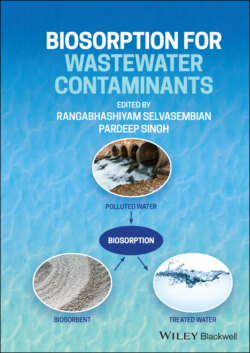Читать книгу Biosorption for Wastewater Contaminants - Группа авторов - Страница 26
Biosorbents
ОглавлениеBiosorbents are biological elements such as bacteria, agricultural wastes, and municipal byproducts employed in the passive removal of toxins from a system. They have been encouraged since they are made from renewable resources, they are cheap and biologically degradable, and they do not produce toxic compounds after being used. Since they are biological material, they include several functional groups that act as the driving force for hydrophobic interactions, which are mostly pH‐dependent during the sorption process. Biosorbent contains a range of functional sites, including carboxyl, imidazole, sulfuryl, amino, phosphate, sulfate, thioether, phenol, carbonyl, amide, and hydroxylate, in contrast with mono‐functional ion‐exchange resins. A large number of natural materials have been suggested as promising biological agents for removing pollutants from water. The sources can be inactive or dead microbial biomass, as well as living microorganisms. It is well understood how some biosorbents function, whereas others need more research. The toxicity of some of these biomaterials also requires in‐depth analysis (Adewuyi, 2020).
Biosorbents, unlike mono‐functional ion‐exchange resins, possess functional groups that can bind and sequester metal ions. The functional groups may be amide, carbonyl, imidazole, sulfhydryl, thioether, amine, sulfonate, carboxyl, imine, and phosphodiester. The ability of a biosorbent to bind metal ions is characterized as its biosorption capability and defined as the number of metal ions biosorbed per unit weight of the biosorbent. This can be stated by using the mass balance equation as shown here:
(2.1)
The metal's biosorption effectiveness (R %) is calculated using the following equation
(2.2)
where qe = total metal ions adsorbed by the adsorbent (mg/g); Ci = original metal ion concentration in the solution (mg/L); Ce = metal ion concentration in the solution (mg/L); V = medium volume (L); and m = quantity of biomass used during the process of adsorption (g) (Kanamarlapudi et al., 2018).
